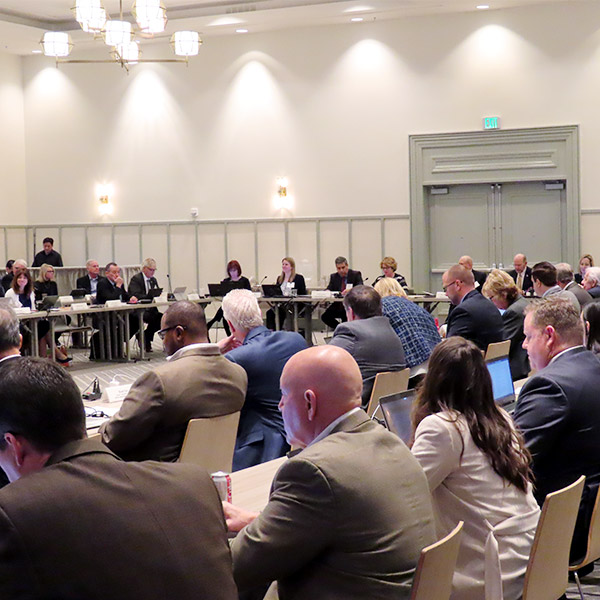Fire victims unhappy with Pacific Gas and Electric’s reorganization scheme urged U.S. Bankruptcy Judge Dennis Montali to reject it Thursday, while others asked him to appoint an examiner to look into allegations of voting problems.
The victims had most of Thursday to make their cases during the second day of arguments over whether Montali should confirm or deny PG&E’s Chapter 11 plan. (See Lawyers Argue PG&E Bankruptcy Plan.) The arguments are scheduled to continue at least through Friday, after which Montali will have to decide whether to accept PG&E’s proposal to exit bankruptcy.
The case began more than 16 months ago as PG&E faced billions of dollars in liabilities for years of devastating wildfires ignited by its transmission lines and other electrical equipment.
During the morning’s session, two lawyers and an individual fire victim contended that many victims hadn’t received ballots in time to vote on the reorganization plan by the May 15 deadline.
“The request for an appointment of an examiner is based on the very large amount of voting procedure irregularities that we’ve now seen,” attorney Bonnie Kane said. “Primarily it appears from the problem of the fire-victim creditors not receiving ballots or receiving them after the time in which they could vote.”
Montali disputed the idea that there were a large number of irregularities.
Of the approximately 80,000 fire victims sent ballots, about 50,000 responded, voting overwhelmingly for PG&E’s plan, Montali said. (See PG&E Bankruptcy Moves Toward Conclusion.) It isn’t unusual for many people not to vote in bankruptcy cases, as well as in presidential elections, he said.
“There are 50,000 people who voted, and by my count, less than 1,000 who may be, for whatever reason, in that category” of those who experienced voting difficulties, the judge said. “I don’t consider that large in relation to the 50,000 who voted.”
The vote by fire victims to approve the plan by a margin of approximately 85% wasn’t even close, he noted.
“This isn’t a city council election,” where the winner is decided by 15 votes, he said.
Montali gave more credence to fire victim Theresa Ann McDonald, who said she wanted to learn if voting problems occurred and why — just as she had wanted to know if PG&E started the Camp Fire, which burned down her home in Paradise, Calif., in November 2018.
The utility has acknowledged its equipment started the Camp Fire, the deadliest and most destructive in state history.
“Those are all pieces in putting the entire puzzle together,” McDonald said.
She said Montali could appoint an examiner after approving PG&E’s plan, allowing the bankruptcy case to move forward.
PG&E lead attorney Stephen Karotkin contended even that could jeopardize the funding the company needs to emerge from bankruptcy by casting a cloud of uncertainty over its plan.
“The debtors will be going out to the market to raise equity capital of $9 billion in the most efficient manner possible, and to have an overhang of a potential examiner here will impact the ability to effect that marketing effort on the best possible basis,” Karotkin said.
After hearing all the arguments, Montali said he would rule on the matter later.
‘Exposed to Risks of Fire’
Later in the day, fire victim William Abrams, a frequent self-represented litigant in the case, urged Montali to reject PG&E’s reorganization plan because, he said, it fails to ensure that a safe and financially stable utility emerges.
“This plan put together is not in good faith,” Abrams said. “Its primary goal is to ensure that entrenched investors can cash out and exit the stock — to leave victims and the public living among the PG&E lines, exposed to risks of fire and risks associated with the fires that they cause.”
Abrams and his family had to flee their home in Santa Rosa, Calif., in October 2017, as the Tubbs Fire roared through the city. State fire investigators said PG&E equipment didn’t start the fire, but the company agreed to settle with victims as part of its restructuring.
Abrams repeated the argument that fire victims are the only large group of creditors being asked to accept PG&E stock as part of their settlement agreement. (See Skeptics Get Last Chance to Sound off on PG&E Plan.) Half of a $13.5 billion victims’ trust is expected to be funded with the utility’s stock, which could diminish in value or become worthless, he said.
PG&E said it hopes to attract “traditional utility investors” after bankruptcy, but the utility won’t pay dividends for years, he said.
“I don’t see how that is possible,” Abrams said.
The state and the California Public Utilities Commission will have to solve PG&E’s safety and financial problems within months after it leaves bankruptcy, including by raising rates, he argued.



